Understanding Portable Ultrasonic Clamp-On Flow Meters
⬅ Back to Posts
Portable ultrasonic clamp-on flow meters are versatile and highly practical devices used to measure the flow rate of liquids in pipes without the need for invasive installation. These flow meters are particularly valuable in scenarios where flexibility, ease of use, and temporary measurement are essential, such as in maintenance checks, system diagnostics, and flow surveys across various industries.
How Portable Ultrasonic Clamp-On Flow Meters Work:
Portable ultrasonic clamp-on flow meters operate on the same principle as stationary ultrasonic clamp-on meters, primarily using transit-time or Doppler techniques to measure flow. The device consists of one or more ultrasonic transducers that are clamped onto the exterior of the pipe. These transducers emit and receive ultrasonic signals that travel through the pipe walls and the fluid inside.
In the transit-time method, the flow meter measures the difference in time it takes for the ultrasonic signals to travel downstream with the flow and upstream against the flow. This time difference is used to calculate the flow velocity, which, combined with the pipe's cross-sectional area, determines the volumetric flow rate.
In the Doppler method, the device measures the frequency shift of the reflected ultrasonic waves caused by particles or bubbles within the fluid. This shift correlates with the flow velocity, allowing the meter to measure flow in fluids with some degree of particulate or entrained air.
Key Advantages
Portability and Flexibility: The most significant advantage of portable ultrasonic clamp-on flow meters is their portability. They can be easily transported and quickly installed on various pipes without the need for cutting into the pipe or halting the process. This makes them ideal for temporary measurements, flow verification, and troubleshooting across multiple locations.
Non-Invasive Measurement: Like all clamp-on meters, the portable version provides non-invasive flow measurement, meaning there is no contact with the fluid or disruption to the flow. This feature is crucial in applications where cleanliness, safety, or fluid integrity is a concern.
Ease of Use: These devices are typically user-friendly, with intuitive interfaces that allow for quick setup and real-time flow monitoring. Many models come with data logging capabilities, enabling users to record flow data for analysis and reporting.
Versatility: Portable ultrasonic clamp-on flow meters can be used on various pipe materials and sizes, making them suitable for a wide range of applications. They are capable of measuring different types of liquids, including water, chemicals, and oils, in both clean and somewhat contaminated conditions.
Applications
Field Testing and Diagnostics: Portable ultrasonic clamp-on flow meters are commonly used in field testing to verify flow conditions, diagnose issues, or measure flow in temporary setups.
Maintenance and Audits: These meters are used in maintenance routines to check the performance of installed flow meters or to audit system flow rates for efficiency and accuracy.
Emergency Measurements: In situations where quick flow data is needed—such as during a system malfunction or unexpected shutdown—portable meters provide immediate insights without requiring complex installation.
Challenges and Considerations
While portable ultrasonic clamp-on flow meters offer numerous benefits, their performance can be influenced by factors such as pipe material, fluid type, and installation conditions. Ensuring good contact between the transducers and the pipe surface is crucial for accurate measurement. In addition, users should consider the fluid's properties, as the presence of excessive bubbles, solids, or highly viscous fluids can affect the accuracy of the readings.
Portable ultrasonic clamp-on flow meters are a powerful tool for professionals needing flexible, non-invasive flow measurement across diverse applications. Their ease of use, portability, and versatility make them ideal for temporary or spot measurements, system diagnostics, and maintenance tasks. With proper selection and usage, these meters provide accurate and reliable flow data, helping to optimize processes and ensure system integrity.
